Dixieland Cabaret
In late March 1922 Auckland was abuzz with the news that a new cabaret called the Dixieland was soon to open. Rumours were swirling – courtesy of an extended campaign in the newspaper women’s columns – about its luxurious appointments and spacious dance floor. The advertisements hinted at exciting events in the evening and during the day. In the situations vacant columns were jobs for waiters, waitresses, and musicians: “First-class cornet, banjo and trombonist for jazz band. Apply, Mr Arthur G Frost, Dixieland Cabaret.”
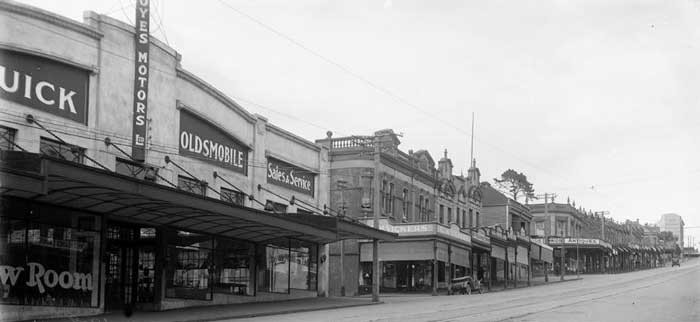
438 Queen Street c.1930s
Located at 438 Queen Street, where Real Groovy Records was situated until January 2016, the Dixieland was the brainchild of Canadian heiress Ethel Rayner and her husband, dentist and entrepreneur Dr Fredrick Rayner. (He owned and operated the American Dental Parlours in Auckland, had a kauri milling operation, subdivided Piha, and had several other business ventures.) They had immigrated to New Zealand at the turn of the century, but continued to travel frequently, especially to North America. Having experienced American and European nightlife, the Rayners decided Auckland needed a glamorous evening venue that incorporated the latest entertainment trends.
The Rayners hired Del S Foster as the Dixieland’s manager. Another expatriate American, Foster was a former vaudeville performer with J C Williamson’s. He introduced Auckland to American-style cabaret by holding cabaret evenings in the Auckland Town Hall. Like the Rayners, he wanted to increase the sophistication of Auckland’s evening entertainment. At the Dixieland, Foster also taught the latest jazz dances.
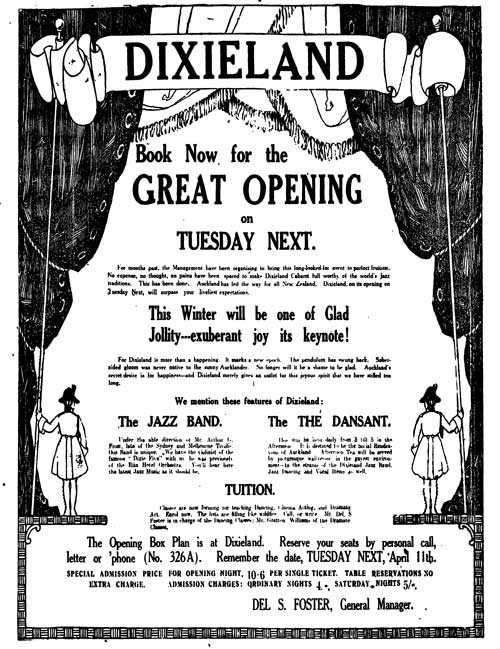
The NZ Herald, 6 April 1922
The Opening
The opening night on 11 April 1922 was a great success. The New Zealand Herald and Auckland Star both featured lengthy reviews, dedicating entire paragraphs to describing the interior decoration and furnishings. The Herald noted the “handsome and artistic” tables and chairs, and the “rich carpets, stained woodwork and well-designed curtains”. The Auckland Star reported that Richard Arthur Ltd had decorated the “spacious lounges containing luxurious furnishings”. Built onto a raised platform, these lounges “afforded those ‘sitting out’ a fine view of the gay throng below”. Both newspapers mentioned the “dazzling lights” from the electric chandeliers and the lamps on each table as well as the spotlights that picked out “the whirling colours on the floor below”. They also gave great attention to the 3000-square foot dance floor: how well it was laid, and how easy it was to dance on. Indeed, it lived up the management’s boasts that it was the perfect dance floor.

The Auckland Star, 7 April 1922
The band at the opening was the Southern Dixieland Band led by violinist/ pianist Arthur Frost. A former musical director at the Sydney and Melbourne Tivoli Theatres, Frost was invited by the Rayners to provide a band for the debut season. He was unable to find the right musicians in Auckland and brought a band from Australia instead. The five-piece band featured a saxophone, trumpet, trombone, drums, and piano. For some reason, the trumpeter that Frost engaged was unable to come, so he hired 18-year-old Auckland trumpeter Vern Wilson as a replacement.
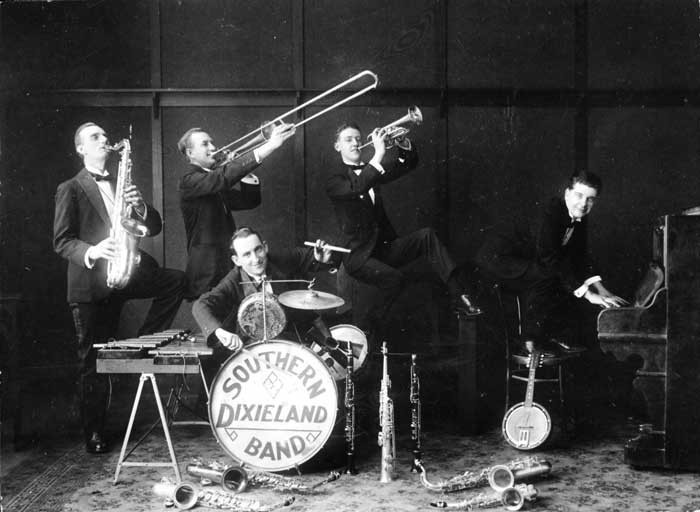
The Southern Dixieland Band, from left: Ces (Pop) Little (saxophone), Fred Swanberg (trombone), Aby Green (drums), Vern Wilson and Arthur Frost (piano and leader).
- Dennis Huggard Archive, Alexander Turnbull Library, Wellington
The Southern Dixieland Band received short, rapturous reviews from the commentators of newspapers entertainment and women’s columns. According to the Herald’s entertainment reporter, the band was “beyond criticism as a jazz orchestra” at the opening, while NZ Truth's “Lady Chain” editor described the band as “perfectly delightful”. In contrast the reviewer for the Auckland Star allowed that they were “composed of capable artists skilled in rendering appropriate music for cabaret dancing.” Possibly this reviewer was attempting to appear blasé and cosmopolitan in the face of all this glamour.

The Dixieland dancefloor in 1922
The Bands
According to trumpeter Vern Wilson, the opening of the Dixieland Cabaret, and the Southern Dixieland Band really helped to popularise jazz in Auckland. There were several other jazz bands in Auckland by 1922 (such as Bob Adams’ Jazz Band – the first jazz band in Auckland, established in 1918), but they were still a novelty. The importation of jazz records to New Zealand was also still sparse – the Original Dixieland Jazz Band’s 1917 recordings were only being imported to New Zealand in 1922 – and the availability of jazz records mostly depended on the whims of labels, shops, and salespeople. The Dixieland Cabaret quickly became the premier jazz venue, and the house band the best-known jazz band, in Auckland.
The Southern Dixieland Band remained at the Dixieland until September 1922 and their residence had quite an impact on the Auckland jazz scene. Newspapers hailed the band as being talented and professional, and praised them for their repertoire, which included “the latest and most distinctive in jazz music”. From the reviews of the band in the press it appears that the Southern Dixieland Band had quite a different approach to jazz from the other jazz bands in Auckland. Contemporary responses from musicians outside of the band are unknown, although Wilson later stated that he thought that the Southern Dixieland Band was the first real jazz band to perform in New Zealand.
After the departure of the Southern Dixieland Band composite Australian/ New Zealand bands such as Hyman’s Jazz Orchestra and Sutherland’s Jazz Band resided for short seasons at the Dixieland. Asides from the leader’s surnames in the band names very little was ever written about these bands, except for the fact that they played excellent jazz. In mid-1923 the Dixieland’s management established a house band, the Dixie Five. Unlike the Southern Dixieland Band neither the Dixie Five nor the later house band, the Dixieland Internationals, garnered much press attention.
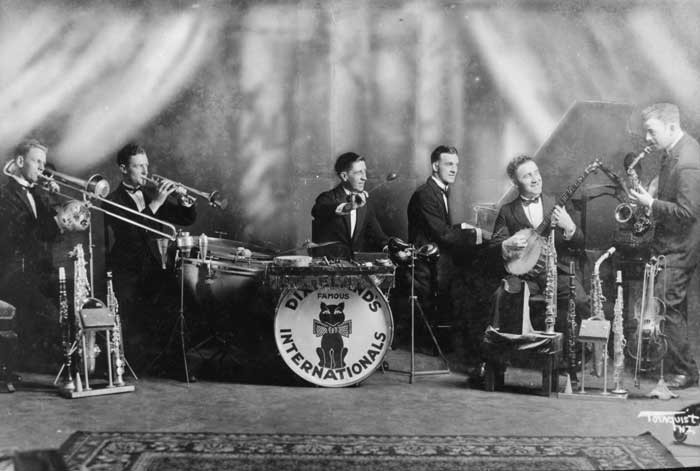
Later in the 1920s, the house band at the Dixieland Cabaret on Queen Street was the Dixieland Internationals - Dennis Huggard Archive, Alexander Turnbull Library, Wellington
Because of the lack of press attention only a little is known about any of these bands. Vern Wilson played in several of the Dixieland’s house bands in the 1920s and 1930s starting with the Southern Dixieland band as an 18 year old. He recalled that the band played non-stop from about 8pm to midnight (or 1am on a Friday) with only a short break while the patrons were at supper. The repertoire for the Dixieland was a rotation of waltz, one-steps and foxtrots. The evening would begin and end with a slow waltz, and there might be a few novelty dances such as the Bunny Hug, the Castle Glide, or the Tango. While Wilson thought that the dances were a bit monotonous, he observed that people really seemed to like dancing to them because “you could really grab hold of a girl” – a dramatic shift from the old time dancing where there would be space between the partners.
The bands at the Dixieland were the best paid in town during the 1920s and even during the 1930s at the height of the Depression it was still better paid than most gigs. When Wilson performed in the Dixieland bands in the 1920s that band members would be paid approximately £1.0.0 per gig (for six nights a week and occasionally a tea dance on Saturday afternoons). This was a good wage for a musician in the 1920s, but most musicians still needed day jobs – it was an fair wage for a single man with no dependents, but not if you were trying to provide for a family (the minimum wage for men in 1925 was about £220 per annum).
Naturally the wages musicians earned also varied with time. Wilson also recalled that during the Depression years, at many venues musicians were lucky if they made 10 to 15 shillings a night. The Dixieland Cabaret did not drop the musicians’ wages per night, but they did reduce the nights per week that they opened, at the lowest point only opening one night per week.
Thé Dansant and Dancing Lessons
The Dixieland was not just an evening venue for supper, dancing, and occasionally a floorshow; there were other activities that helped to keep it financially afloat. The thé dansant (tea dance) was a popular way of getting patrons, frequently women, into the cabaret during the day. It was “intended that discriminating people should take afternoon tea there, with a dance or two thrown in”. A high tea with possibility of jazz dancing (and the permissibility of women dancing together) to records or the house band proved quite exciting for men and women whose schedules allowed them the time to socialise during the day.
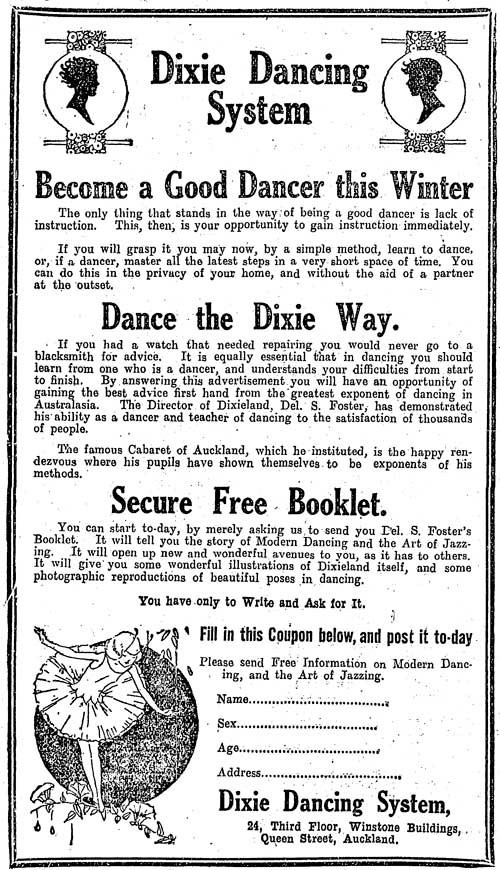
NZ Truth, 12 August 1922
In the 1920s and 1930s dancing was one of the best ways for people to meet, socialise, and romance potential spouses. As a result of the dancing boom (the 1920s is frequently called the dancing decade by historians) dance studios and dance lessons at cabarets were more commonplace than bars are today. At the Dixieland, lessons in the latest dance styles and steps were a big draw for Aucklanders who wanted to keep up with the latest trends. The Foxtrot, jazz (both the specific dance and the general style), Blues, Tango, and later the Black Bottom and the best known of all 1920s dances, the Charleston, were all taught at the Dixieland. Del Foster instituted a special simple method of learning to dance that all the teachers at the Dixieland followed, promising fast results that would have you out on the dance floor in no time. Private lessons, as well as classes, were available for those wanting more specific instruction on the finer points on the new styles of dancing. These lessons greatly benefited the Dixieland in two ways: as well as paying for lessons students would naturally frequent the cabaret for some of their social dancing, ensuring venue loyalty.
Scandals
During the 1920s and 1930s cabarets such as the Dixieland were supposed to be dry – no alcohol allowed to be served. However, many venues, including the Dixieland bent and occasionally broke this law to give customers what they wanted. The Dixieland was one of the more infamous venues, repeatedly being cited for ignoring and even aiding patrons bringing alcohol onto the premises. Although the management appeared to have obeyed the letter of the law in not serving or selling alcohol on the premises they had glasses that patrons could rent for the evening for a small fee.
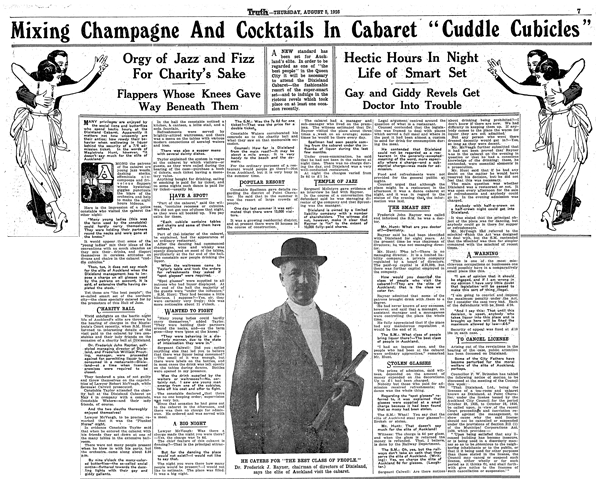
NZ Truth, 5 August 1926. Full size image
Such flouting of the law attracted the attention of the courts and New Zealand Truth. In 1926 Fredrick Rayner and the current manager of the Dixieland were called to appear before a magistrate regarding repeated breaches of the liquor laws. New Zealand Truth decided to supplement their reporting of this case with their own investigation into the activities of Auckland’s smart set attending the Dixieland. To their “shock” they found that not only were patrons imbibing alcohol, they were also cuddling in the cabaret’s private cubicles. The result was an almost page long article detailing the debauchery of the patrons and the repeated breaches by the management. The salaciousness of the article no doubt engendered a great deal of tutting among Auckland’s conservative elements, but did not appear to harm the Dixieland in the slightest. In fact the article and the court case might have made it even more attractive to Bright Young Things looking for a wild night out.
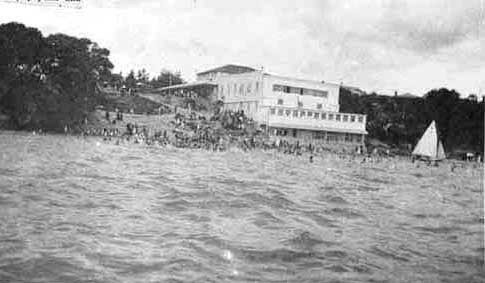
Dixieland By the Sea, Point Chevalier
Dixieland – By the Sea (Point Chevalier)
In October 1925 the Dixieland moved from its premises on Queen Street to larger premises on the waterfront in the suburb of Point Chevalier. The second incarnation of the Dixieland Cabaret was reportedly just as lavish as the original Dixieland, but much larger: Dixieland By the Sea could accommodate up to 600 patrons and the dance floor had been increased to 3600 square feet. To make up for the inconvenience of being out in the suburbs the management of the Dixieland had free shuttle buses running to and from Queen Street, with the last bus of the evening getting back to town in time to catch the last tram home if patrons did not wish to drive.
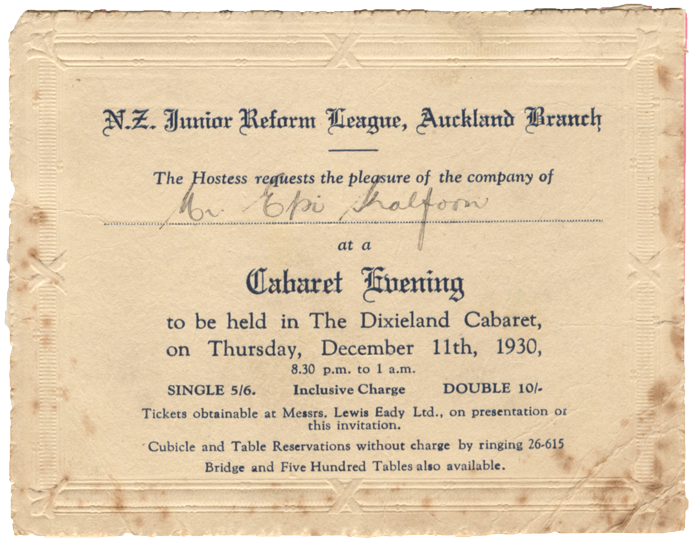
A night out for Epi: in 1930 bandleader Epi Shalfoon was still Rotorua based, but beginning to make forays to Auckland, where he and the Melody Boys would be based from the mid-1930s – Shalfoon family
The new venue was located at the bottom of Point Chevalier Road within just a few metres of the water. The New Zealand Herald and Auckland Star reviews noted that the new cabaret had “an uninterrupted view” of the harbour and as it opened onto the shore the sea breezes would make it considerably cooler than its previous city location. This, the reviewers felt, was more in keeping with American and European practices, making the cabaret even more fashionable and cosmopolitan. Both reviewers raved about the furnishings, the dance floor, the soda fountain and the modern electric catering facilities. It was clear that Dixieland Point Chevalier was going to be as much of as success as the original Queen Street cabaret was.
The Point Chevalier incarnation of the Dixieland Cabaret operated successfully for a decade, even through the height of the Great Depression. They expanded their operation from a cabaret with afternoon tea dances, to having tearooms built onto the front of the building and extensive bathing facilities (“capable of accommodating 700 swimmers”) for easy access to the harbour waters. Its reign as the most luxurious cabaret in Auckland ended suddenly though, early on 9 September 1935. A lit cigarette butt was carelessly dropped on a couch at the end of the evening’s dance. At 3.30am the roar of flames that were devouring the cabaret woke the cabaret’s manager, Mr VH Trask, who lived in the adjoining residence. Although the fire brigade was on the scene within minutes it was all they could do to contain the fire and prevent it spreading to neighbouring residences. The Dixieland Cabaret was burned almost entirely to the ground.
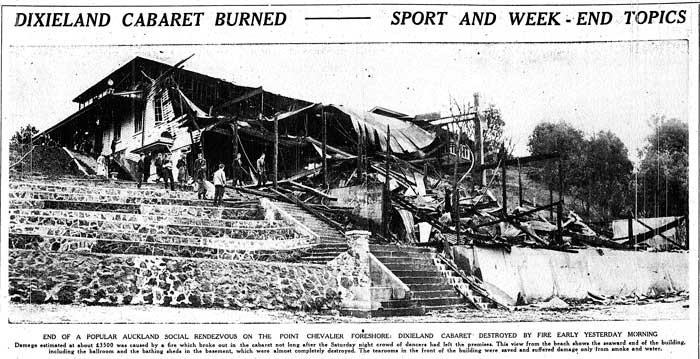

The NZ Herald, 9 September 1935
Postscript – The New Dixieland
Five years after the Dixieland burned down in Point Chevalier a group of musicians and Dixieland Cabaret fans worked together to revive the illustrious venue in its original venue on the corner of Queen and Waverly Streets. In the years since the Dixieland had moved out to Point Chevalier the upper story of the building had become a mechanic and motor dealer (Tappenden Motors), but the lower level continued to be used as entertainment facilities for a variety of groups. In late July 1939 the New Dixieland Cabaret opened with a roster of the best swing bands in Auckland to play for the swing and jitterbug fanatics. Norm Crowder, Art Larkin, Epi Shalfoon, and Johnny Madden’s bands were all regular performers at the cabaret, which quickly became a rival to the big inner city cabarets: The Peter Pan Cabaret, Cabaret Metropole and the Civic Wintergarden. It was not to last however, and by 1943 it had disappeared from the Auckland scene. This was the final end of the Dixieland Cabaret Auckland’s first glamorous cabaret and night spot.
–
With thanks to Papers Past.